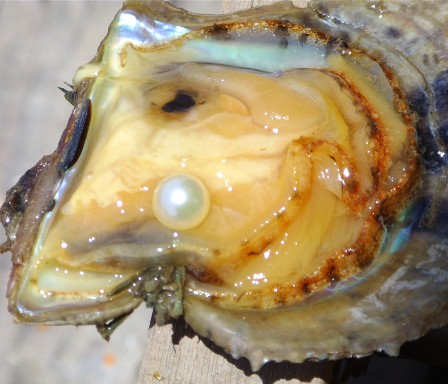HOW PEARLS ARE CREATED

Pearls are formed when an irritant finds its way inside some particular types of molluscs, or when something is purposely inserted inside them. They’re made of the same substance which is found on the inside part of the shell. Natural pearls are formed when a grain of sand or irritant enters the mollusc while for cultured pearls a spherical core of mother-of-pearl is inserted manually inside the mollusc. In both cases ther mollusc starts secreting layers of conchiolin and calcium carbonate, the same substance found in the shell. Pearls are thus formed as a defence mechanism to protect themselves from the irritant.Natural pearls have always been extremely rare and very expensive, but cultured pearls because of the complex and time-consuming technique necessary to produce them, are just as precious as natural pearls.
The quality of pearls depends on numerous factors. First and foremost, it is determined by the layer of mother-of-pearl around the central nucleus: the thicker the layer, the shinier the pearls. A thicker layer means that more light can reflect on the pearl, giving it a shiny lustre.The Orient refers to the depth of the reflection of the pearl, making it seem as if light comes from within. Size is another important factor. Saltwater pearls vary between 3mm and 10mm, and in very rare cases can be bigger. However, the larger the nucleus, the bigger the chance that the mollusc can reject the irritant or even die. Thus, there is a very low production of large pearls making them extremely expensive
.jpg)
.jpg)
The shape of the pearl is a criterion that defines its value. Perfectly round pearls are rare as most are semi-round or flat or even irregular in shape. Irregular shaped pearls, known as “baroque” because of their bizarre shape, have always inspired artists and craftsmen to create exclusive and unique jewelry.Pearls come in a variety of shades of color ranging from white, silver, pink, ivory, to cream, champagne, grey, gold, green, blue, black. A pearl’s color depends on the characteristics of its place of origin, the conditions of the water of cultured pearls, and the presence or particular types of micro-organisms that molluscs feed on. Purity is another important factor that determines the value of a pearl and any cracks, holes, marks or stains decrease its value.
SOME TYPES OF PEARLS
.jpg)
Akoya Pearls
These pearls are cultured seawater pearls produced by the mollusc Pinctada Fucata, also known as Akoya oyster. They’re cultivated in Japan and now even in China; they’re considered to be the most classical pearls and are very lustrous and are generally white with shades of silver, pink, ivory and cream. They vary between 2mm to 10mm.
.jpg)
Australian Pearls
These are saltwater pearls produced by the Pinctada Maxima mollusc, a much larger mollusc than the Akoya one. Australian pearls vary between 8mm to 20mm. These pearls are found in the south seas in Australia, Indonesia and the Philippines and are satin white with shades of silver or gold.
.jpg)
Tahitian Pearls
These are seawater cultured pearls from the mollusc Pinctada Margaritifera, found in the islands of Polynesia and Micronesia. The large size of the mollusc produces larger pearls which range between 8mm to 18mm, and they come in shades of grey, silver, green, bronze and purple.
.jpg)
Keshi Pearls
These pearls are produced when the host pearl rejects the nucleus which was previously implanted inside the shell of the mollusc towards the end of the culturing stage, and are therefore irregular because they don’t have a nucleus. Since they are 100% mother of pearl, they are very lustrous, even more so than pearls that were cultured with a nucleus. Their color ranges from silver white to pink to grey but they are becoming more and more rare because of the X-rays done in the culturing phase to identify the rejection of the nucleus in time, and therefore be ready to implant a new foreign object before the mollusc produces the Keshi pearl.
.jpg)
Freshwater Pearls
These pearls are produced in lakes or rivers in Japan and China. They are not as shiny as saltwater pearls, and they are not perfectly round. In the last years, new techniques have contributed to improving the color and shape and they have become more similar to saltwater pearls. Their size varies between 3mm to 12mm. Since they don’t have a nucleus, these pearls are made entirely from the secretion of the nacre when an irritant is placed inside the mollusc. Freshwater pearls come in a variety of natural shapes and colors, and have a low production cost.